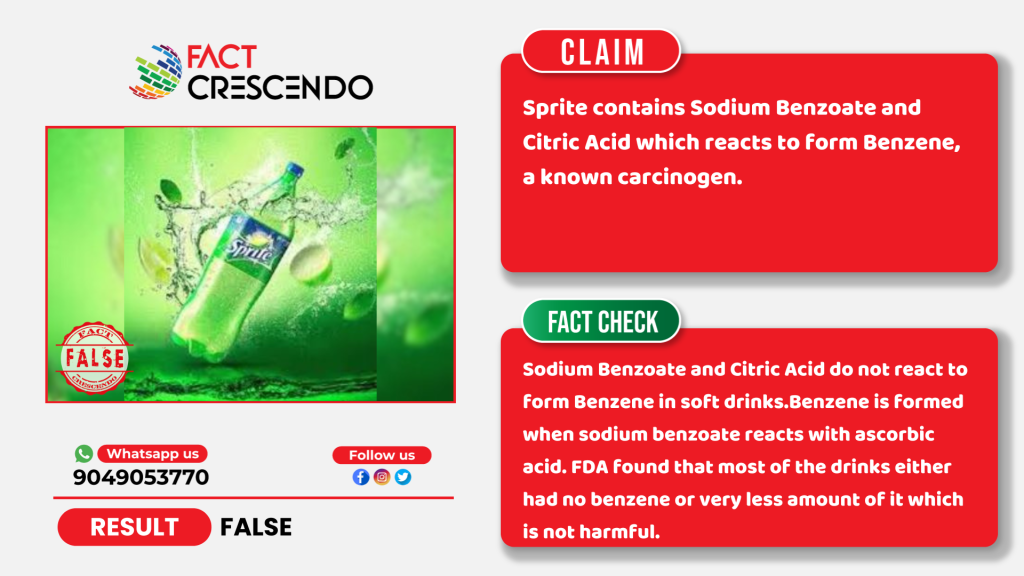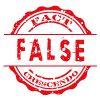
Sprite, one of the most loved drinks, owned by the Coca-Cola company has come into limelight again after netizens raised their concerns about its safety. A lot of soft drinks are adding additives to increase the shelf life of the products.
Consumers are now concerned about the presence of Sodium Benzoate and Citric acid in Sprite. According to the claim, both these substances react with each other and release Benzene, a carcinogenic substance. This makes the drink unsafe.
However, Fact Crescendo found the claim to be misleading. Benzene is formed after Sodium Benzoate reacts with Ascorbic acid and not Citric Acid.
What’s the Claim?
A social media user wrote, “There are no safe levels of benzene exposure because it’s so toxic at very low levels. The petroleum-based chemical “causes cancer”, especially leukemia and in blood forming organs, the US Department of Health and Human Services wrote. The toxin has also been shown to harm the central nervous system and reproductive organs.”
Facebook | Archive
Fact Check-
According to the information available on the Coca-Cola website, Sprite contains carbonated water, high fructose corn syrup, citric acid, natural flavors, sodium citrate, and sodium benzoate.
According to the FDA, Benzene is a carcinogen that can cause cancer in humans. Center for Food Safety and Applied Nutrition (CFSAN) surveyed almost 200 samples of soft drinks and other beverages tested for benzene conducted from 2005 through May 2007. They found a small number of products sampled contained more than 5 parts per billion (ppb) of benzene.
The US Environmental Protection Agency (EPA) has established a maximum allowable level (MCL) for benzene in drinking water of 5 ppb. FDA has adopted EPA’s MCL for drinking water as an allowable level for bottled water.
CFSAN’s survey found that benzene levels in beverages do not pose a safety concern, with most samples containing no benzene or levels below 5 ppb. These results align with findings from national and international agencies and the beverage industry.
According to the National Library of Medicine, there are no legal limits for benzene in foods or beverages, but potable water standards are used as a reference. WHO has set the limit to 10 parts per billion (ppb) (WHO), 5 ppb set by EPA, USA, and 1 ppb by European Council. In 2011, Brazil’s Federal Public Ministry (MPF) set a 5 ppb benzene limit for three major soft drink manufacturers.
Cancer Association of South Africa (CANSA) conducted a study to determine whether benzene could be formed in Vitamin C-containing soft drinks that also contained the preservative Sodium Benzoate. Samples from various brands were purchased and tested at an independent laboratory. The results showed that none of the tested samples contained benzene, confirming their safety for consumption. However, consumers are advised to check product labels for Sodium Benzoate and make choices.
According to another study, benzene which is a cancer causing chemical, forms in drinks that contain benzoate salt and ascorbic acid (Vitamin C) or erythorbic acid. It was found that light and head speeds up the reaction, while sugar and EDTA helps prevent it. During the study, 199 soft drinks were tested and it was found that most of them had little or no benzene in it. Some drinks had more than the safe limit (5 ng/g), so manufacturers changed their formulas. After reformulation, benzene levels dropped to safe amounts (0–1.1 ng/g) or were no longer detectable.
According to the FDA, Benzene, a cancer-causing chemical, can form in small amounts in some soft drinks containing sodium benzoate and vitamin C. The FDA tested beverages between 2005 and 2007 and found that 10 samples had benzene levels above the safe limit of 5 parts per billion (ppb). These products were either reformulated or discontinued, and their benzene levels were reduced to safe amounts. The FDA states that current benzene levels in drinks are not a safety concern.
Center for Food Safety, HongKong mentioned in an article that in early 1990s, Benzene was found in soft drinks containing both Benzoic acid or its salts and Ascorbic acid, especially in the presence of light and elevated temperatures. It is important to note that the presence of benzoic acid or its salts and ascorbic acid in soft drinks does not necessarily lead to the formation of benzene. Various factors, such as pH levels, exposure to high temperatures and UV light, and the presence of certain minerals and sweeteners, may influence benzene formation.
Fact Crescendo contacted former Project Associate-2 of CSIR-Indian Institute of Chemical Technology, Hyderabad. We were told that sodium benzoate, a widely used food preservative, undergoes a double displacement reaction with citric acid, leading to the formation of benzoic acid and sodium citrate. While concerns exist about benzene formation, the likelihood is low under normal food processing and digestion conditions, as its formation requires complex reaction mechanisms, catalysts like copper or zinc, and specific environmental factors like UV exposure. Additionally, sodium ascorbate, sometimes mentioned as a byproduct, acts as an antacid rather than a hazard. Overall, sodium benzoate remains safe in regulated concentrations.
Conclusion:
Fact Crescendo found the claim to be false. Sodium Benzoate and Citric Acid do not react to form Benzene in soft drinks. Benzene is formed when sodium benzoate reacts with ascorbic acid, another kind of Vitamin C. FDA also found that most of the drinks either had no benzene or very less amount of it which is not harmful.

Title:Sodium Benzoate and Citric Acid in Sprite Do Not Cause Benzene Formation.
Written By: Siddharth SahuResult: False


